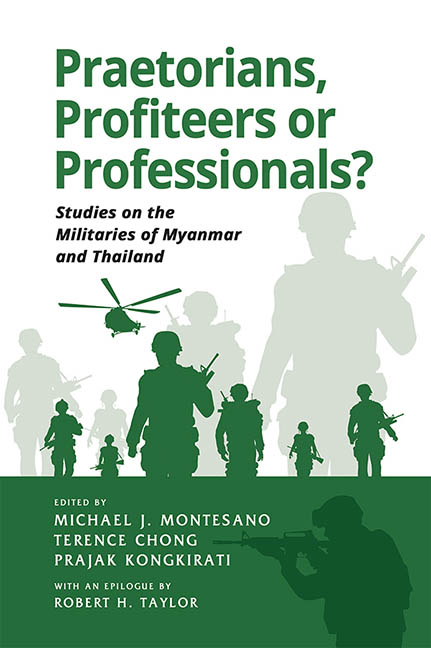Book contents
- Frontmatter
- Contents
- Acknowledgements
- About the Contributors
- 1 Introduction: Two Mainland Southeast Asian Militaries in Comparative Perspective
- 2 A New Tatmadaw with Old Characteristics
- 3 Thailand’s Military: Ideology and Sense of Mission
- 4 The Defence Expenditures and Commercial Interests of the Tatmadaw
- 5 The Economic Role of the Thai Military: A Commercial Logic to Coups?
- 6 Epilogue: Controlling or Playing Politics?
- Index
4 - The Defence Expenditures and Commercial Interests of the Tatmadaw
Published online by Cambridge University Press: 09 October 2021
- Frontmatter
- Contents
- Acknowledgements
- About the Contributors
- 1 Introduction: Two Mainland Southeast Asian Militaries in Comparative Perspective
- 2 A New Tatmadaw with Old Characteristics
- 3 Thailand’s Military: Ideology and Sense of Mission
- 4 The Defence Expenditures and Commercial Interests of the Tatmadaw
- 5 The Economic Role of the Thai Military: A Commercial Logic to Coups?
- 6 Epilogue: Controlling or Playing Politics?
- Index
Summary
From a relatively small number of troops at the time of the country's independence in 1948, the Tatmadaw, or Myanmar Armed Forces, has grown into one of Southeast Asia's formidable militaries, even while details on the total number of troops and units are difficult to ascertain. Indeed, they remain a matter of secrecy. Undoubtedly, the Tatmadaw is today far better equipped than it was when it took over the state three decades ago, in September 1988, in the name of the State Law and Order Restoration Council (SLORC)—to become the State Peace and Development Council (SPDC) in 1997. The cash-strapped socialist regime of the Burma Socialist Programme Party (BSPP), which ran the country from 1974 to 1988, had, despite its best effort to look after the military, done little to modernize the Tatmadaw. The latter thus remained a poorly equipped force, relative to its peers in the region. It was essentially a counter-insurgency force with almost no capability to engage in conventional warfare.
Since the early 1990s, the Tatmadaw has pursued a force modernization programme, procured military hardware from various foreign sources, and expanded Myanmar's defence-industrial bases. In the last five years, Commander-in-Chief Senior General Min Aung Hlaing has repeatedly confirmed his commitment to build the Tatmadaw into a “Standard Army”, although the concept has never been properly defined. In recent years, the Tatmadaw has received some of the advanced weapon systems, fighter aircraft and warships available on the international arms market. In addition, it has improved troops’ combat gear and equipment. All of this has required an injection of large amount of money into defence spending.
Throughout 1990s and 2000s, the Tatmadaw leadership repeatedly reminded its commanders that the force had to be built by four means: administration, training, welfare, and morale. Troops’ welfare is thus an essential part of building a “modern, strong and highly capable” Tatmadaw. In his address at the fifty-fourth Armed Forces Day Parade on 27 March 1999, Commander-in-Chief Senior General Than Shwe explained what he meant by building the Tatmadaw by means of welfare.
Welfare is also an organizational activity. It supplements discipline. It also boosts morale. Therefore, welfare is essential in strengthening the Tatmadaw's capabilities
- Type
- Chapter
- Information
- Praetorians, Profiteers or Professionals?Studies on the Militaries of Myanmar and Thailand, pp. 97 - 131Publisher: ISEAS–Yusof Ishak InstitutePrint publication year: 2020



